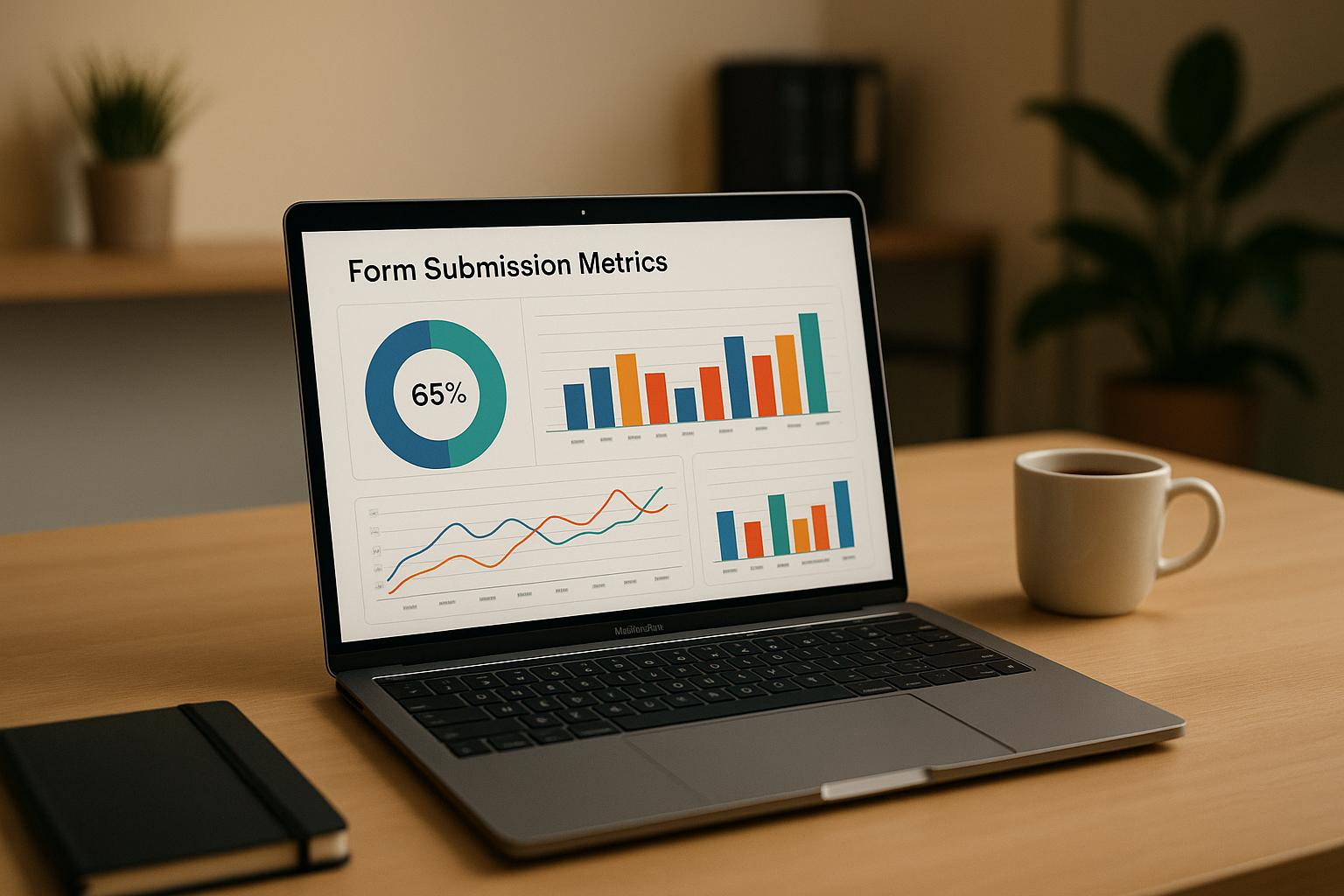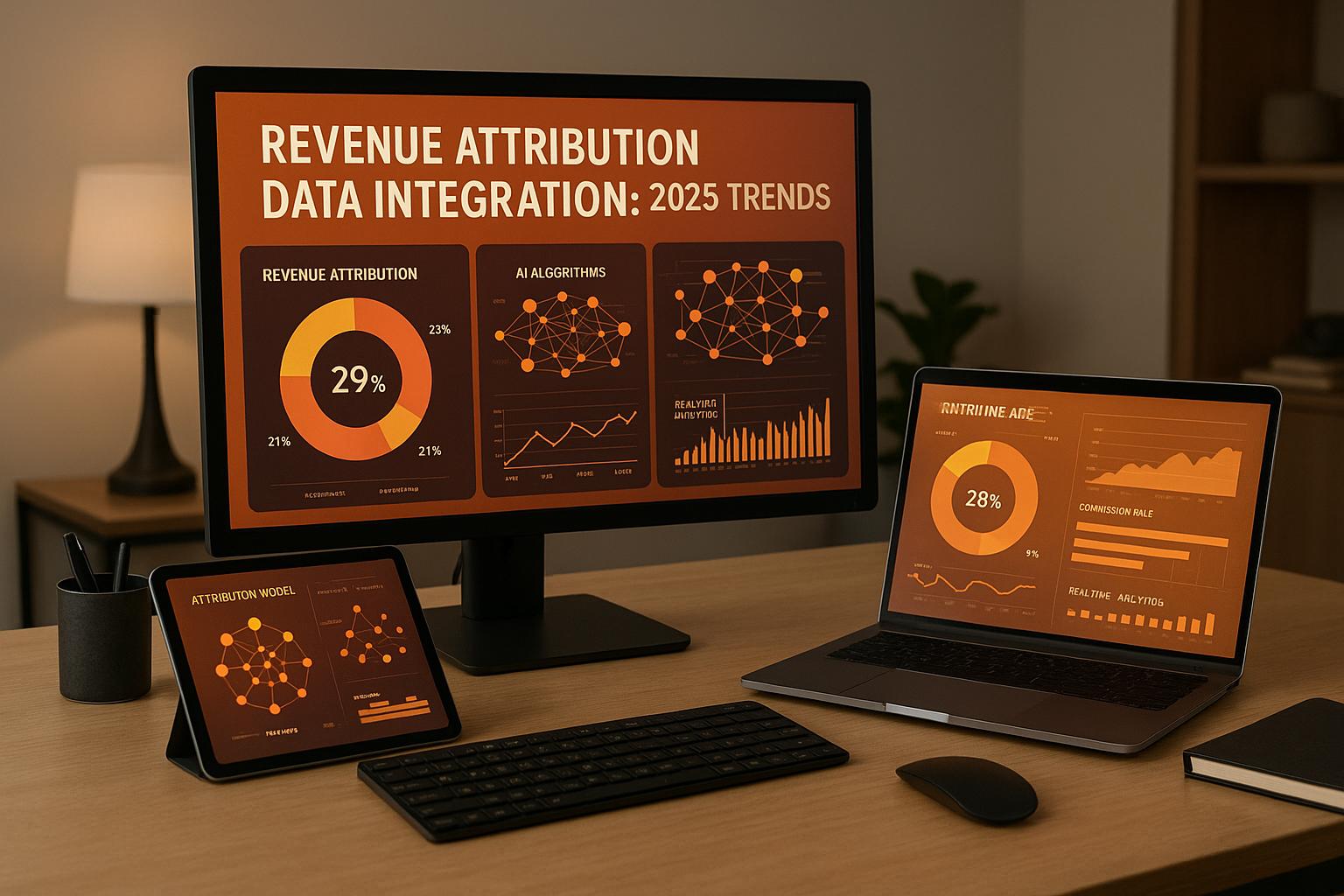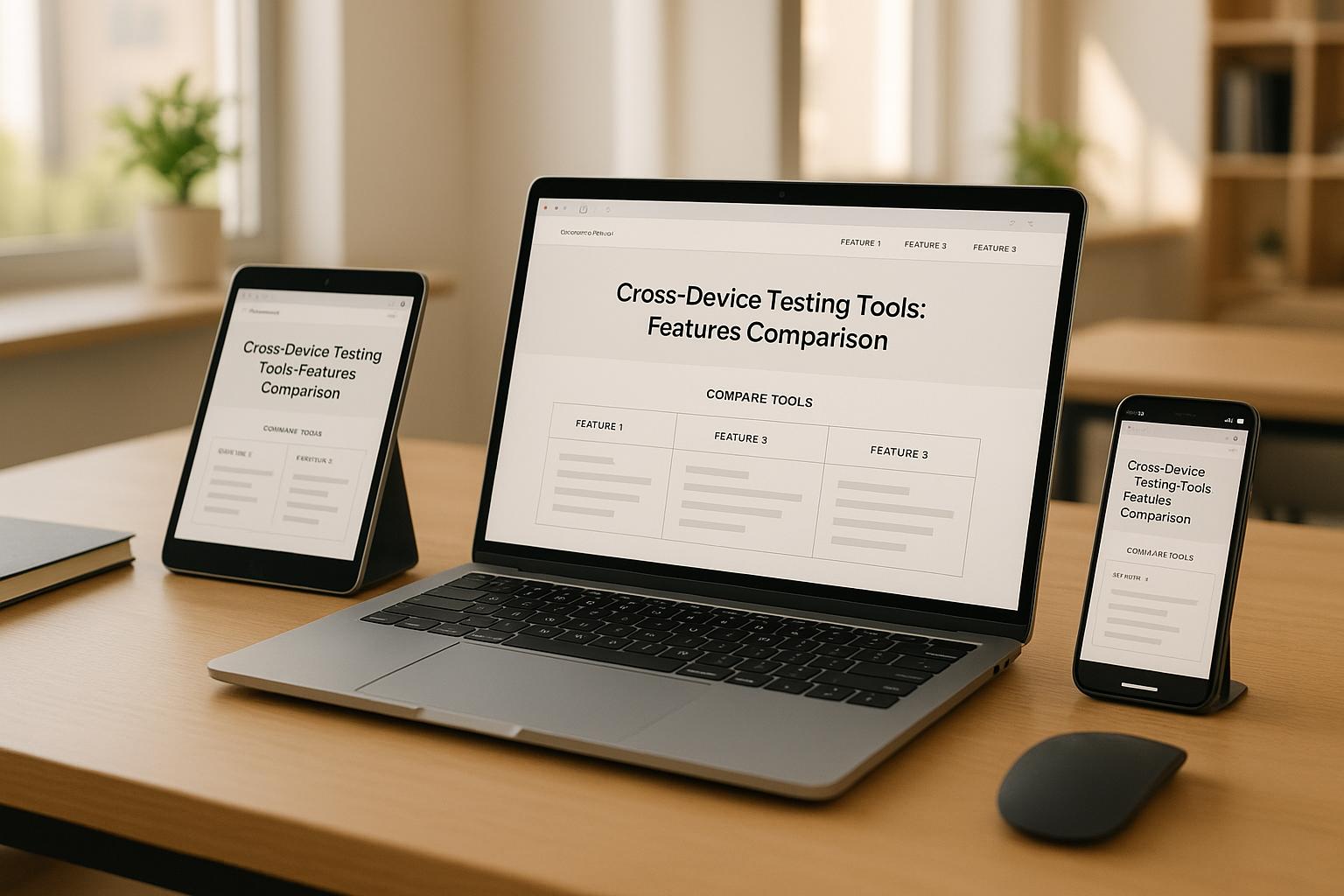Video ROI can be effectively measured using these five key metrics:
-
Conversion Rate
Tracks the percentage of viewers who take a desired action, like making a purchase or signing up. Videos can boost conversion rates by up to 34%. -
Cost Per Lead (CPL)
Measures how much you spend to generate a single lead. For example, LinkedIn videos average $75 per lead, while Facebook videos are more cost-efficient at $18.68. -
Engagement Rate
Reflects how viewers interact with your video (likes, shares, comments). The average engagement rate across industries is 41%. -
Average View Time (AVT)
Indicates how long viewers stay engaged. Shorter videos (under 2 minutes) retain 70% of viewers, while retention drops for longer content. -
Click-Through Rate (CTR)
Measures the percentage of viewers who click on a call-to-action. CTR benchmarks vary by platform, with TikTok leading at 5–15% and YouTube averaging 4–5%.
Quick Comparison
| Metric | Purpose | Example/Benchmark |
|---|---|---|
| Conversion Rate | Tracks actions taken | E-commerce videos: 10–30% |
| Cost Per Lead (CPL) | Measures lead generation cost | Facebook: $18.68; LinkedIn: $75.00 |
| Engagement Rate | Tracks interactions | Average: 41% |
| Average View Time | Measures viewer retention | Short videos: 70% retention |
| Click-Through Rate | Tracks CTA effectiveness | TikTok: 5–15%; YouTube: 4–5% |
Why These Matter:
These metrics provide actionable insights into how your video content performs across platforms and stages of the marketing funnel, helping you optimize strategies to improve ROI.
How To ACTUALLY Measure Your Video ROI!
1. Conversion Rate
Conversion rate tracks the percentage of viewers who take a specific action, such as making a purchase or signing up for a service. Businesses using video marketing see 34% higher conversion rates, making it a key metric for boosting ROI.
Here’s the simple formula to calculate video conversion rate:
| Metric | Formula |
|---------------------------|-------------------------------------------|
| Video Conversion Rate (%) | (Number of Conversions / Total Views) x 100 |
Conversion rates can vary depending on the platform and video type. For example:
- E-commerce product videos: 10–30%
- Instagram Reels and Stories: 2–4%
- YouTube videos with CTAs: 2–3%
- TikTok videos: 3–6%
"Online video ROI isn't solely about numbers - it's about transforming engagement into revenue." - Dr. Amelia Roberts, Marketing Professor at MIT
How to Improve Conversion Rates
1. Strategic Placement
Where you position your videos matters. Websites featuring video content have an average conversion rate of 4.8%, compared to 2.9% for those without. Place videos prominently, such as above the fold on landing pages or product pages, to grab immediate attention.
2. Technical Optimization
Quality and speed are crucial. Videos shot at 720p resolution or higher see a 312% increase in conversions compared to lower-quality content. Additionally, ensure videos are compressed and mobile-friendly to avoid slow load times. A delay of just two seconds can spike bounce rates by 103%.
3. Content Structure
Tailor your video length to its purpose:
- Product demos: 2–5 minutes
- Explainer videos: 60–120 seconds
- Testimonials: 1–2 minutes
Real-World Success Stories
Optimized video strategies can lead to astounding results. For instance, Puma’s "shop as you watch" campaign achieved an earnings-per-click rate 24 times higher than the e-commerce industry average. Personalized videos can boost conversion rates by up to 20%, and interactive elements increase engagement by 66% and extend viewing times by 44% compared to static media.
For businesses looking to track and analyze these metrics effectively, tools like the Marketing Funnels Directory provide valuable insights, enabling data-driven decisions that deliver measurable ROI.
2. Cost Per Lead (CPL)
Cost Per Lead (CPL) is a critical metric that shows how efficiently your video marketing efforts turn investments into qualified leads. It measures the cost of acquiring each potential customer.
How to Calculate CPL
The formula for calculating CPL is straightforward:
CPL = Total Marketing Spend / Number of Leads Generated
For instance, if you spend $5,000 on video production and promotion, add $1,000 for content distribution, and gain 20 new leads, your CPL would be $300 per lead.
Average CPL Benchmarks by Platform
Here's a look at the average CPL across popular platforms:
| Platform | Average CPL |
|---|---|
| Facebook Video Ads | $18.68 |
| Instagram Video | $25.00 |
| LinkedIn Video | $75.00 |
| Google Display Ads | $90.80 |
| Video Marketing Campaigns | $174.00 |
Reducing Video CPL
1. Choose the Right Platform
Different platforms have varying CPL rates. For example, LinkedIn's $75 per lead cost often delivers higher-quality B2B leads. On the other hand, Facebook's $18.68 CPL is better suited for B2C campaigns aimed at larger audiences.
2. Tailor Your Content
Develop video content that directly addresses the needs and interests of your target audience. Personalized, focused content tends to perform better.
3. Optimize Technically
To lower your CPL, focus on technical improvements like:
- Ensuring your videos are mobile-friendly
- Speeding up video load times
- Placing videos prominently on landing pages
- Using retargeting campaigns to re-engage potential leads
CPL by Industry
CPL can differ significantly depending on the industry:
- Travel: Average CPL is $106
- Retail: Average CPL is $34
Tools like the Marketing Funnels Directory can help businesses track these metrics across campaigns and platforms, providing insights to refine CPL strategies.
A Real-Life Example
A B2B company spent $800 creating a whitepaper and promoted it using LinkedIn video ads. The campaign resulted in 40 professional downloads, achieving a $20 CPL. This example highlights how well-planned video content can generate leads cost-effectively.
Up next, we’ll explore how engagement metrics add another layer to understanding video ROI.
3. Engagement Rate
Engagement rate, much like conversion rate and CPL, is a key factor in shaping your video ROI strategy. Across industries, the average video engagement rate is 41%. This metric captures how viewers interact with your content - through likes, comments, shares, and other actions.
Understanding Video Engagement Metrics
Engagement metrics provide insights into:
- How well your content resonates with your audience
- The development of brand loyalty
- A video's potential to go viral
Platform-Specific Engagement Benchmarks
Each platform has its own engagement trends and preferences:
| Platform | Key Engagement Indicators |
|---|---|
| Silent viewing dominates (85% mobile) | |
| Quick, visually-driven interactions | |
| Professional and industry-focused engagement | |
| YouTube | Watch time and subscriber growth |
To maximize engagement, tailor your videos to each platform. For example, add captions for Facebook, focus on strong visuals for Instagram, highlight industry-relevant topics for LinkedIn, and dive deeper into educational content for YouTube.
Real-World Success Story
A great example of engagement-driven success comes from Off The Beaten Track. In 2024, they collaborated with 400 influencers to create video content, reaching 750,000 customers. This effort generated 44% of their e-commerce revenue directly through social media engagement.
Improving Engagement Rates
Here are some proven strategies to boost engagement:
- Video Structure
"Focus on the first five seconds. You really want to work on how your videos start and figuring out what your hook is." - Joe Sloan, Advice Media
- Viewer Interaction
"The most effective way to improve your video engagement is by asking viewers a question. In the video, tell users to comment by answering the question, and your engagement will skyrocket." - Jonathan Aufray, Growth Hackers
- Technical Optimization
- Use subtitles, as 85% of Facebook users watch videos without sound
- Design eye-catching thumbnails
- Keep videos concise - around 2 minutes is ideal
- Format videos specifically for each platform
Measuring Success
To gauge how well your videos are performing, monitor these metrics:
- Watch Time
- Social Shares (videos are shared 1,200% more than text and images)
- Comments
- Retention Rate
- Interactive Elements
Tools like the Marketing Funnels Directory can help you track these metrics across platforms, making it easier to identify which videos resonate most with your audience.
Expert Insight
"Create videos that are actually valuable and entertaining to your audience instead of just sharing a message you believe is important." - Derek Doeing, G2 Crowd
4. Average View Time
Average View Time (AVT) is a key metric that tracks how long viewers stay engaged with your video content. It’s a strong indicator of whether your content is holding their attention. According to industry data, videos under two minutes tend to retain about 70% of viewers, while longer videos often see retention rates drop below 50%.
Benchmarking Success
To set realistic goals, it helps to understand what good performance looks like:
| AVD Performance Level | Retention Rate | Interpretation |
|---|---|---|
| Excellent | 70%+ | Exceptional engagement |
| Very Good | 60–70% | Strong viewer interest |
| Good | 50–60% | Decent performance |
| Poor | Below 40% | Needs improvement |
With these benchmarks in mind, you can focus on strategies that improve viewer retention.
Platform-Specific Duration Guidelines
Each platform has its own sweet spot for video length, which can significantly impact view time:
| Platform | Optimal Duration | Key Considerations |
|---|---|---|
| YouTube | 5–15 minutes | Ideal for in-depth content |
| 15–60 seconds | Perfect for quick, engaging stories | |
| Up to 2 minutes | Best for professional insights | |
| TikTok | 15–60 seconds | Suited for fast, dynamic clips |
Tailoring your video length to the platform’s audience is crucial for maximizing engagement.
Proven Strategies to Increase View Time
"We've started adjusting the ranking of videos in YouTube search to reward engaging videos that keep viewers watching".
"High-quality audio and video go a long way to keeping a viewer watching. If you have cheap microphones and cameras and generally poor production, your viewing metrics such as Average View Duration, Click-Through Rates, and Views of your other videos will be poor".
Technical Optimization Tips
- Use a variety of visuals to keep viewers engaged.
- Add timestamps for easier navigation in longer videos.
- Ensure clear, crisp audio quality.
- Include captions to cater to silent viewers.
Success Story: Strategic Video Optimization
MKBHD, a tech YouTuber, showcases how polished editing, stunning visuals, and well-paced transitions can significantly improve viewer retention.
Measuring Impact
The Marketing Funnels Directory provides tools for tracking and improving video performance. Better view times not only enhance audience engagement but also boost ROI by making your content more effective.
"Video is a big part of our strategy–it's the most informative and interesting way to get your message out. From dynamic animated logos to how-to videos and short format social media video, it hits all the marks for introducing our clients to solutions, putting our brand out there, and catching your eye in a high-value way!".
sbb-itb-a84ebc4
5. Click-Through Rate (CTR)
After understanding view duration, CTR provides another essential way to evaluate how well a video performs. CTR tracks how often viewers click on calls-to-action (CTAs), links, or ads. It’s a key indicator of how effectively your video inspires action, making it critical for measuring return on investment (ROI).
Platform-Specific CTR Benchmarks
CTR expectations vary by platform, with each having its own range of what’s considered good performance:
| Platform | Good CTR Range |
|---|---|
| YouTube | 2–10% (average ~4–5%) |
| TikTok | 5–15% |
| 1–2% | |
| 1–3% |
How CTR Impacts Video Marketing ROI
Including videos in email campaigns can increase click rates by an impressive 96%. Additionally, LinkedIn users are 20 times more likely to share video content compared to other types of posts.
"Click-through rate (CTR) is a marketing metric that measures how often a link, ad, or email is clicked in relation to how many times it's shown."
- Appsflyer
Optimizing CTAs for Better Results
The placement of CTAs in your video can significantly influence CTR. Here’s how to strategically position them:
- Opening 15 seconds: Clearly communicate your value proposition upfront.
- Mid-video: Introduce related content or special offers to keep viewers engaged.
- Final 30 seconds: End with a strong, actionable CTA to drive conversions.
You can use tools like the Marketing Funnels Directory to test and refine these strategies while tracking performance.
Real-World Example: ABC Financial Advisors

ABC Financial Advisors revamped their CTA approach by focusing on urgency and value. Their new tagline, "Schedule Your Complimentary Financial Review Today!" led to a 50% increase in consultation bookings within just one month.
Best Practices for Boosting CTR
Technical Tips:
- Design eye-catching, high-contrast thumbnails.
- Use clear, action-oriented language in your CTAs.
- Optimize for mobile devices and test CTA placements through A/B testing.
- Personalize CTAs to resonate with specific audience segments.
"Higher clicks on your video title or thumbnail raise its search ranking."
- Jackson Gartner, White Peak Digital
Strategic Moves:
- Create a sense of urgency with limited-time offers.
- Use clickable buttons and overlays to make actions easy.
- Ensure your video content aligns seamlessly with the messaging on your landing page.
CTR doesn’t just measure clicks - it’s a direct reflection of how well your video motivates viewers to take action. By analyzing CTR and applying these strategies, marketers can sharpen their overall approach and maximize video ROI.
Metrics Comparison
Let’s break down how these metrics function across different stages of the marketing funnel and their unique contributions to overall strategy.
Funnel Stage Analysis
| Metric | Funnel Stage | Main Role | Best Platform |
|---|---|---|---|
| Engagement Rate | Top/Middle | Gauging Interest | Social Media |
| Average View Time | Middle | Assessing Quality | YouTube, Vimeo |
| CTR (Click-Through Rate) | Middle/Bottom | Driving Action | All Platforms |
| CPL (Cost Per Lead) | Bottom | Generating Leads | Landing Pages |
| Conversion Rate | Bottom | Measuring Sales | Website |
These metrics work together to paint a clearer picture of your audience's journey through the funnel, providing insights into how they collectively influence ROI.
Platform-Specific Performance
Different platforms excel at tracking specific metrics. For example, YouTube offers detailed view data, including average watch time, while social media platforms focus on immediate engagement metrics like likes, shares, and comments. Tools like Wistia go a step further, providing heatmaps and drop-off analytics, which are invaluable for fine-tuning video content and placement strategies.
Metric Relationships and Dependencies
Metrics don’t exist in isolation - they interact and influence one another. A high CTR, for instance, might seem promising, but if conversion rates lag behind, it points to a weak post-click experience or misaligned landing pages.
"Measuring video marketing success isn't just about tracking numbers - it's about understanding your audience, optimizing your strategy, and delivering meaningful results."
- James Bryant, Forbes Councils Member
ROI Impact and Platform Performance
Metrics at different funnel stages play distinct roles in driving ROI:
Top Funnel Metrics:
- Engagement rates reveal how well your content resonates with the audience.
- Average view time provides insight into content quality and its ability to hold attention.
- Combined, these metrics can hint at the likelihood of eventual conversions.
Bottom Funnel Metrics:
- CPL evaluates how cost-effective your lead generation efforts are.
- Conversion rates measure the ultimate success of turning leads into customers.
Platform performance varies widely. For instance, YouTube is known for longer view durations, while social platforms like Instagram or Facebook often deliver higher engagement rates. This variability helps businesses set realistic expectations and allocate resources where they’ll have the most impact.
Optimization Strategies
The Marketing Funnels Directory provides detailed insights into how these metrics perform across platforms. Recent studies show that optimizing user experiences - such as improving page load times or simplifying navigation - can boost conversion rates by as much as 400%.
Success Indicators
Tracking the right metrics at the right stage is key to evaluating campaign performance:
Early Stage:
- High engagement rates signal that your content is striking a chord with your audience.
- Strong average view durations indicate that viewers find your content valuable.
- Consistent CTRs show that your calls-to-action are effective.
Late Stage:
- A declining CPL reflects more efficient lead generation.
- Improving conversion rates highlight the effectiveness of your sales funnel.
- A growing ROI confirms that your campaigns are delivering tangible results.
"Understanding your CPL is like having a financial compass for your marketing strategy. It gives you the clarity needed to evaluate whether your campaigns are performing well or wasting resources."
Conclusion
Video marketing has become a cornerstone for businesses, with 91% leveraging it as a key tool in 2024. To ensure success, measuring and optimizing metrics like conversion rate, cost per lead, engagement rate, average view time, and click-through rate is essential. These metrics offer a clear framework for refining strategies and boosting ROI.
By focusing on these metrics, businesses can uncover insights that shape smarter decisions. Tools like the Marketing Funnels Directory simplify tracking across platforms, enabling brands to elevate their video marketing efforts.
"When you take the time to track and analyze your video marketing performance, you gain more than just numbers - you gain actionable insights that guide your future efforts. Every metric is a piece of the puzzle that helps you refine your strategy and maximize ROI."
For example, SproutVideo users see an average play rate of 30% and a 58% engagement rate, underscoring the value of a detailed tracking approach.
"To stay ahead in video marketing, prioritize tracking these key metrics: engagement, CTR, conversion rate, and ROI. Consistently optimize your content based on these insights to drive long-term success."
Effective tracking pays off - 90% of businesses report positive returns from video marketing in 2024. With video messages being remembered by 95% of viewers compared to just 10% for text, keeping a close eye on these metrics is vital for thriving in today’s marketing landscape.
FAQs
What are the best video marketing metrics to track for improving ROI?
To get the most out of your video marketing efforts, keep a close eye on key performance metrics that can guide your decisions. Start by looking at engagement metrics - things like watch time, views, and social shares. These numbers show how well your content is resonating with your audience.
Then, focus on conversion rates to see how effectively your videos are driving actions, whether it's purchases, sign-ups, or inquiries.
Don't forget to dig into audience demographics as well. Understanding who your viewers are can help you create content that speaks directly to their interests and needs. By paying attention to these metrics, you can fine-tune your strategy, improve your results, and boost your ROI.
What are some effective ways to lower the Cost Per Lead (CPL) for video marketing campaigns?
To bring down your Cost Per Lead (CPL) for video campaigns, start by fine-tuning your audience targeting and sharpening your content strategy. Focus on reaching people who are most likely to engage - like those already familiar with your brand or lookalike audiences. This can lead to better engagement, higher-quality leads, and reduced costs.
Another smart move is to run A/B tests on your video content, ad formats, and placements. Testing reveals what clicks with your audience, helping you allocate your budget where it counts. Also, make sure your lead forms are as simple as possible - cutting down on unnecessary fields can increase completion rates and drive more conversions.
Don’t forget to keep a close eye on your campaign performance metrics. Regularly review the data to spot underperforming ads and adjust your approach accordingly. Even small, consistent tweaks can add up over time, helping you make the most of your budget and reduce CPL effectively.
What is Average View Time (AVT), and how can it improve the success of your video content?
Average View Time (AVT)
Average View Time (AVT) shows how long viewers stick around to watch your video. It's a powerful indicator of how engaging and effective your content is. The longer people watch, the more likely they are to remember your brand and take action - whether that's making a purchase, signing up, or sharing your video.
Want to boost your AVT? Start with a strong hook - something that grabs attention in the first few seconds. From there, keep your audience interested with eye-catching visuals, a clear and compelling story, and dynamic editing that keeps the pace lively. You can also sprinkle in interactive elements like polls or calls-to-action to encourage viewers to stay engaged right until the very end.


